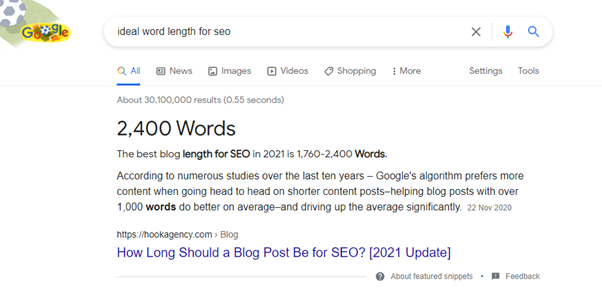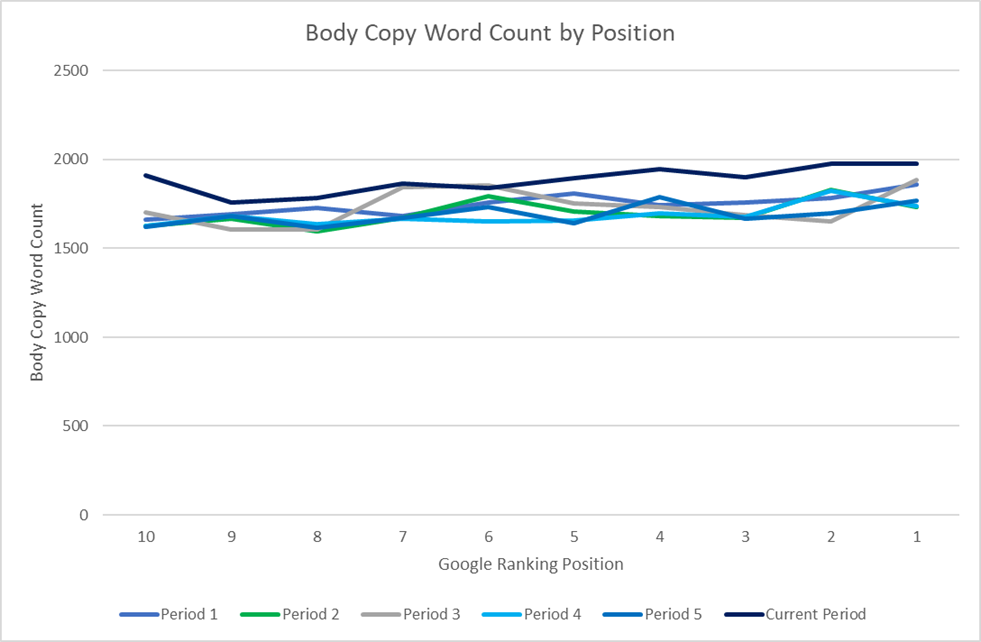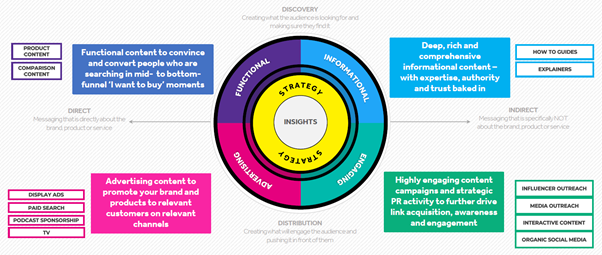“How long should my content be?” is a question that comes up a lot. In fact, it came up several times at a Content Marketing Masterclass that we hosted recently. Just what is the optimal length for a piece of content if we want a page to rank in Google, to engage our audiences and to guide them through to a conversion? And whilst it’s a difficult and nuanced question to answer, we’re going to try and answer it anyway.
The truth is that, if we could answer that question simply by saying “500-600 words”, this would be a straightforward question with a straightforward answer. But, perhaps annoyingly, it isn’t as simple as that and there isn’t a really simple “ballpark” quantity of words that you should aim towards, for the most part at least. But we can at least try and inform that thinking to a point.
Let’s start by asking Google.
OK, the answer to this is never going to be this simple, but what does a simple Google search tell us?

There we have it. A search result in ‘position zero’ telling us that 2,400 words is the “sweet spot” for a blog if you want it to rank organically in Google search.
But you’re not suddenly going to start stretching all of your content out into the length of a university assignment, and neither should you because most of your content, as good as it may be, simply doesn’t merit that level of written prose.
How about some objective benchmarking?
Google is ultimately using an algorithm to rank content and to assess factors such as quality, depth and relevancy, so we could theorise that there must be some objective measure of content depth that we can correlate with organic search rankings. And that’s something that we can empirically test. Indeed, your site CMS may use a plugin of have a feature that recommends a certain volume of text (WordPress users will likely be familiar with Yoast, as one such example).
Using one of our in-house tools, Roadmap, we can find correlations between organic search visibility and content length.
At the time of writing, Roadmap puts the correlation between body word count and page ranking at 74.24%, and is the 52nd highest correlating factor out of just under 270 we analyse. On the face of it, that makes body copy a strong correlating factor, but that isn’t the full story.

What we can see is that in the current period (the purple line), there does tend to be a slight lean towards pages with more content ranking higher in the Google search results pages, with the body copy volume generally trending downwards as we fall down the rankings.
But as we can see from the graph, this trend doesn’t necessarily follow every in every period, and we do see the correlation score fluctuate significantly. Body copy certainly isn’t a reliable factor on which we can build our search strategy alone.
We also know that the ‘ideal’ body copy figure changes dramatically from sector to sector. Using Roadmap, we can analyse prominent keywords in a range of sectors and what we can see is that the “sweet spot” for content varies significantly from sector to sector.

In personal finance for example, the level of content needed to rank for some of the main keyword terms in that sector is significantly higher than it is in sectors like travel of gambling. And interestingly, the correlation is weaker from sector to sector. In insurance, for example, the page ranking in first position has the lowest body copy count of the ten top-ranking pages.
The fact that sectors such as finance or legal services tend to lean towards more substantial content comes as no real surprise. These are sectors where informational sites and (particularly in the case of consumer finance) comparison sites dominate the organic search rankings, where there are high standards and expectations around consumer protection, and these sites serve this demand by providing detailed, trusted and usually impartial content.
This is the sort of behaviour that Google’s EAT guidelines were designed to encourage. Google wants brands and publishers to provide users with content that was created by subject matter experts, delivered with authority, that consumers can trust. And this is where we start to get to the real answer to the question “how long should my content be?”
How long does it take to meet the user’s expectations?
The answer, for all intents and purposes, is that the ideal word length is the number of words it takes to deliver the experience that the user is looking for – to answer the user’s question, to meet their need and to satisfy the user’s intent at that given moment. Some of those moments will require considered, detailed and informative content, others will require content that is much shorter, perhaps much more passive, and straight to the point.
And the truth is that, at different stages of the customer journey, or in different circumstances and contexts, consumers will want different things. A consumer searching for a local location page probably just needs to know your closing time this evening, a Google Maps link and the store phone number; they don’t need 2,000 words detailing the services you can provide there. Someone looking to rearrange their debts is probably expecting more than information than some snippets of content totalling a couple of hundred words.
Content length also needs to reflect the channels that we use to reach and pull in our audiences. It isn’t simply a question of what the ideal content length for Google may be, but what is the ideal content length for a range of different channels, all of which work together to engage audiences, whether that is through organic search, paid search, or any other medium that may engage our audiences at different stages of the journey.
This Is where our Complete Content model helps us to understand the types of content that we need for different purposes. Where we want out audiences to come to us, we can rely on that longer-form content that helps us build relevancy and establish a position in the search rankings – our product content needs to sell the features and benefits of the product and our how-to guides and explainers need to explain how our brand understands our audiences’ challenges. But where we have to go out to our audiences, and engage them on their channels and terms, our approach may be very different. Our content needs to be attention-grabbing, leaning heavily on creative to capture that fleeting audience attention.
We need to put the question into perspective.
Discussions around ideal word length, and attempts to quantify that numerically, tend to approach the matter as if Google is a system to be gamed; that Google is trying to judge content quality objectively and therefore, there must be a level of depth that all good content shares.
Whilst we have seen that we can show correlations between content length and search rankings, we also know that those correlations have their caveats.
We mustn’t allow our fixation on a number – an ideal volume of words – to overlook the empirical principles of good content. We’re not creating content for search engines. We’re creating content that humans will consume in different contexts, with different intents, for different purposes on different channels.
Download our Google EAT Survival Guide

The Google Broad Update of August 2018, dubbed the “EAT” update, has caused a number of brands in competitive search markets to lose organic search visibility. This guide will discuss exactly what has happened, why Google has updated its Search Quality Evaluator Guidelines, and how your brand needs to respond.
This guide will cover:
- An overview of the changes to the Google search algorithm introduced in August 2018.
- How the Google Search Quality Evaluator guidelines have changed, and what the ‘human element’ of Google’s search algorithm is looking for.
- A closer look at the principles of Google’s E-A-T policies, and just what it means for your brand’s SEM strategy.
- How major brands have been impacted by these changes, and why.
- How brands can ensure that they are producing content that meets Google’s E-A-T guidelines, whilst still delivering on their commercial objectives.
- Why expertise, user experience and web functionality are more important than ever as signals of expertise, authority and trust.
Download your free guide today.
